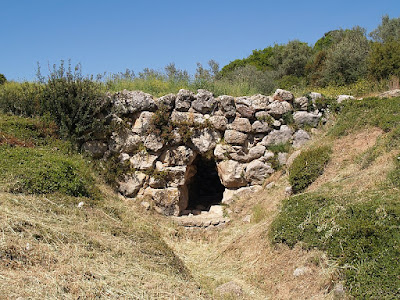Arcadicus Bridge
The Arcadiko Bridge, also known as the Barracks Bridge (current tourist sign/sign: Mycenaiki Gefyra A') is a Mycenaean bridge, located in the village of Arkadiko in Argolis. It is considered the oldest preserved bridge in Europe and probably the world, as well as the oldest single-arch bridge still in use today. The bridge was built in the Bronze Age, probably in the 13th century BC. and was part of the road network that the Mycenaeans had built in the Argolis area, to connect Epidaurus with Mycenae and Tiryns.
A surviving example of Mycenaean bridge construction in Argolis, Peloponnese
The bridge is made of gigantic boulders, characteristic of cyclopean Mycenaean constructions. It is 22 meters long, 5.6 meters wide and 4 meters high. In addition to the Arkadikos bridge, four other similar bridges are preserved in the wider area, the most important being the bridge at Galousi (some sources consider it the oldest) and the "Petrogefiri" (sign: Mycenaiki Gefyra B').
Other Mycenaean bridges in Argolis
The Arkadiko Bridge is one of four known Mycenaean corbel arch bridges near Arkadiko in Argolis. They are all of similar design and age and belong to the same Bronze Age highway between the two cities of Tiryns to Epidauros. One of them is the Petrogephyri bridge, which crosses the same stream 1 km (0.62 mi) to the west of the Arkadiko bridge. The structure, which is otherwise similar in size and appearance, has a larger span and a slightly higher vault. It remains in use as part of a locally used track.
A fifth, well-preserved Mycenaean bridge is located in the wider region at Lykotroupi in northern Argolis, where it was part of another Mycenaean main road.[5][6] Its measurements are close to the Arkadiko Bridge: 5.20 m (17.1 ft) wide at the bottom, 2.40 m (7 ft 10 in) at the top and with a corbelled arch span of a little more than a metre. The road still features stone curbs which would have kept the wheels of fast-moving chariots away from the bridge's edge
Construction method
Like all Mycenaean bridges, the Arcadian bridge rests on large, irregular limestone blocks, which create the so-called "exhortic system". To create this system large stones were first placed in the lower part of the structure on natural rocky ground. The lower part of the opening of the structure (river bed), consisted of a lower plate, which formed a separate, fairly high threshold. Above and around the threshold, horizontal slabs were placed, which provided stability for the lower blocks and, at the same time, bases for another layer of upper blocks. Further up, there was another platform where stones, which formed the road, were probably placed.
The Mycenaeans built bridges with two different expository systems: with an arch or a triangular opening. The movement and placement of the stones was probably done by rolling them during the construction of the bridge, as there is no evidence to prove the existence and use of scaffolding. This theory justifies the partial treatment of the stones in contrast to the sculpted blocks in corresponding cyclopean works of the time.







Σχόλια